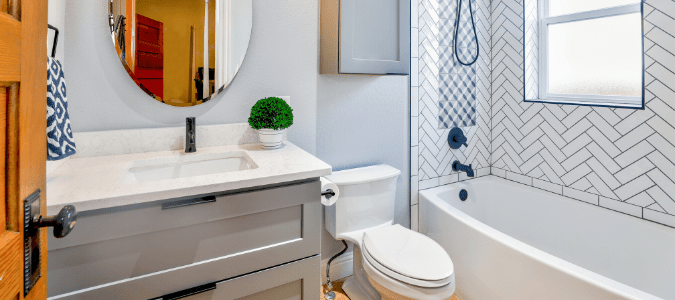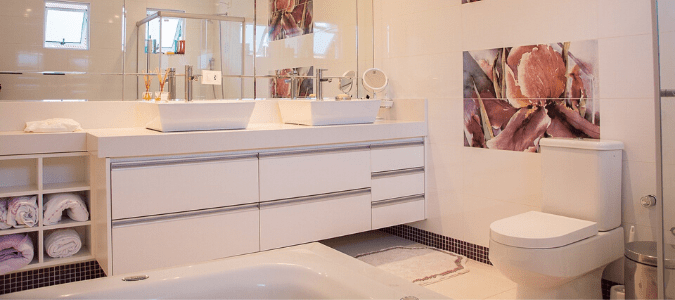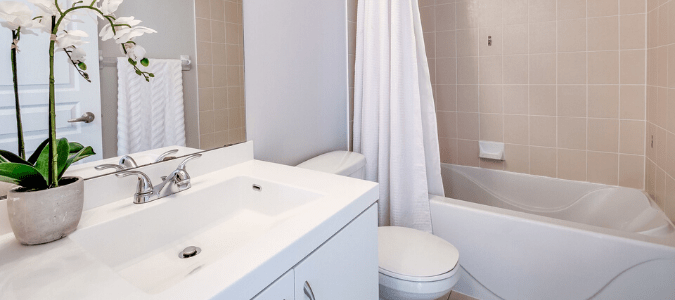
When it comes to home repair emergencies, there is nothing quite like an overflowing toilet. The consequences can be quite serious and can include water damage, mold growth and more. Before addressing the problem, you’ll want to stop the water from flowing. Turn off the water supply to your toilet by tightening the valve that is behind the toilet on the wall. If that doesn’t help, remove the lid off your tank and lift the float that’s at the water’s surface up high enough to stop the flow of water.
Then, shut off your main water supply by closing the main valve outside near the street or by your water heater. If water continues to come out of your toilet, you are most likely dealing with a sewage backup, which is a real plumbing emergency requiring the help of a licensed professional.
If you are able to stop the flow of water, you can then clean up the area and start troubleshooting. Sometimes, homeowners can fix an overflowing toilet on their own. If you understand how your toilet works, you will likely be able to diagnose the issue. Then you can either fix it yourself or explain the problem to the professional you contact for assistance.
Toilets all work in the same basic way. They may use alternate materials or shape the components differently, but the fundamentals do not change.
To trigger the flush, you push a button or a handle. This is connected to a chain on the inside of the tank. The chain is pulled up and lifts the stopper that covers the flush valve. When the flush valve is exposed, gravity pushes water down through the valve and into the toilet tank. This washes away the contents of the toilet bowl and refills the tank. Meanwhile, the tank empties out most of its water. When the tank level is low enough, the stopper falls back into place, covering the flush valve and stopping the escape of water.
The water level dropping also causes the float bobber to sink. This float bobber is connected to a stopper on the fill valve. When the bobber has dropped a certain amount, the fill valve is uncovered and water starts pouring back into the tank. Once the flush valve is covered, the tank starts to refill and raise the float bobber again. When your toilet is working properly, this float bobber will return to its original level and shut the fill valve again. At that point, the tank is refilled, every valve is covered and the toilet is ready to flush again.
Toilets also come with an overflow safety feature called the overflow tube. These tubes live inside the tank. They are supposed to drain water out of the tank and into the bowl if the water level in the tank is too high. If your toilet is constantly running, it may be a sign that the tank water level is too high. The extra water will continually overflow into the bowl, wasting water and creating a constant noise.
When your toilet’s tank is overflowing, there are a couple of potential failure points. In most cases, the bobber is not sealing off the fill valve for some reason. The first and most likely cause is that the bobber is not rising with the water level. The bobber may have come loose from the fill valve. It also might have cracked and no longer be able to float.
Another possibility is that the seal that should cover the fill valve is no longer watertight. If the seal is loose, water will keep flowing, no matter what.
The third option is that your overflow tube is the wrong size. A tube that’s too short will drain water into the bowl constantly unless you lower the bobber. On the other hand, an overflow tube that is too tall will lead to extra water spilling onto the floor.
If your float has come loose, you can usually fix it yourself. Take the lid off of the tank and check to see whether the float is connected to anything. If it’s free-floating, that’s the problem and the lever that it’s supposed to lift will be left hanging. To resolve the issue, lift the lever to seal off the fill valve, then reconnect the float to the end of the lever. This will stop your tank from overflowing almost immediately.
If your fill valve seal is cracked or your overflow tube is the wrong size, you’re better off calling a professional rather than attempting a repair yourself. These types of plumbing repairs are easy to do incorrectly, and making a plumbing mistake can potentially cause more problems down the line. Hiring a licensed plumber is the quickest way to get this kind of repair done right.
Water can also overflow from your toilet tank if the water level is not set correctly. You can adjust the water level in your tank yourself to make sure that the toilet is filled with just the right amount of water. This will keep water from escaping into the overflow tube or leaking out of the tank anywhere else.

How to Adjust the Water Level in a Toilet Tank
The most common cause of an incorrect water level is a poorly adjusted float bobber. The float is attached to a lever, and if the lever is too short or too long, the water level will be too high or too low, which can lead to your toilet leaking.
There are two primary styles of float: ballcock floats and cup floats.
If You Have a Ballcock Float
The older ballcock style of float is screwed onto the lever itself. The other end of the lever is connected to the fill valve seal. When the ball floats high enough, the lever rises to the point where it see-saws and pushes the fill valve seal down. This action closes off the water supply to the tank. The lower the ballcock rests in the tank, the more quickly it will push the fill valve seal down. This keeps the water level lower because the fill valve will close more quickly.
In older models, you can adjust the height of the ballcock simply by gently bending the brass lever up or down. Newer plastic models require a bit more effort. Locate the adjustment screw at the top of the fill valve on the left side of the tank. Turn it screw counter-clockwise to lower the water level, or clockwise to raise the water level.
If You Have a Cup Float
Cup floats, also known as concentric valves, live on the fill valve tube itself. They rise and fall with the water level. Cup floats use adjustment rods to keep the float at the right level. If your cup float is too high, your water level will rise too far and overflow the tank. Here’s how to adjust the cup float water level:
- Locate the cup valve at the top of the fill valve on the left side of the tank.
- Find the adjustment rod connected to the float and the fill valve. At the connection point between the float and the adjustment rod should be a float clip.
- Pinch the float clip to release the float from the adjustment rod, then slide the cup down to lower the tank’s water level. Slide the cup up to raise the water level.
With either style of fill valve mechanism, lowering the water level will help prevent the tank from overflowing.
Whether you’re not confident adjusting your toilet’s water level yourself or you’ve just got better things to do with your time, you may decide to contact a licensed plumber to fix your toilet rather than attempting the repair yourself.

Why Is Your Toilet Tank Leaking?
It’s not always clear whether your toilet tank is leaking or overflowing, and telling what problem you have is important. An overflow is the result of the fill valve never closing. On the other hand, a leak happens because a valve or seal is cracked or otherwise damaged. Knowing what problem you are dealing with can help you more quickly decide your best next steps.
Most toilet tank leaks happen in one of three places: the spud washer, the fill valve or the bolt gaskets. Each of these parts has gaskets and washers that can erode over time. A professional plumber can replace or repair any of these components for you.
The spud washer is the seal between the tank and the bowl itself. Water flows through this location every time you flush. If the leak gets worse when you flush, you may need to have your spud washer repaired.
The fill valve could also be leaking. The fill valve tube goes up through the toilet into the tank, so there are several places where it can leak. If you turn off the water supply to the toilet and the leak stops, you probably have a problem somewhere along the fill valve tube. Fill valve problems can also be responsible for making your toilet flush twice.
Finally, if the leak is constant, as long as there’s water in the tank, the bolt gaskets are probably the culprit. There are two bolts that connect the toilet tank to the rest of the toilet. The gaskets that seal off the boltholes can decay over time, and any leaks there will be slow but steady.
Any kind of leak, overflow or other common plumbing problems can be easily handled by a professional. These experts make plumbing repairs day in and day out and can quickly determine what’s going on and start working on a solution so you can turn your water back on again. You won’t have to worry about spending hours finding the correct parts, learning how to make repairs and having the right tools. A plumber can also help install new parts or replace anything that has worn out over time.
ABC Can Handle Your Plumbing Emergencies
Finding water overflowing from your toilet can be quite alarming. Often the best way to handle the issue is by contacting a licensed plumbing professional. At ABC Home & Commercial Services, our specialists are highly trained and can work on any make or model of toilet in your home. Our specialists can quickly diagnose and fix the problem so you can get back to your day. With ABC’s help, you can feel confident knowing that the job was done right.
